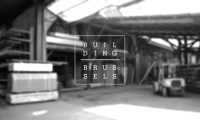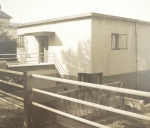The research focused on 19th and 20th-century architects’ houses in the Brussels-Capital Region and aimed to define the characteristics and qualities of these architects’ houses in Brussels. Furthermore, Linsy examined how architects’ houses evolved over time. It was also the aim to elaborate strategies for qualitative restoration and renovation projects. The research was supervised by prof. dr. Stephanie Van de Voorde (VUB Architectural Engineering) and prof. Dr. Inge Bertels (UAntwerpen), in collaboration with Barbara Van der Wee Architects.
Linsy Raaffels
Linsy Raaffels
Ir. Arch. Linsy Raaffels (°1993) worked as a PhD researcher at VUB Architectural Engineering in 2016-2022. She obtained her degree as Master of Science in Architectural Engineering in 2016. She briefly worked on the IRP-project ‘Building Brussels’ in 2016. In January 2017 she started her PhD research ('Doctiris' programme, financed by Innoviris) on 'Architects’ houses in Brussels. Strategies for valorization' under the supervision of prof. dr. Stephanie Van de Voorde (VUB) and prof. dr. Inge Bertels (UA), in collaboration with B. Van der Wee Architects.
Projects
PhD research
Architects' houses in Brussels. Strategies for valorization.
| Date | 2017 - 2022 |
| Supervisors | Stephanie Van de Voorde, Inge Bertels and Barbara Van der Wee |
| Funds | INNOVIRIS (doctiris) |
Master’s thesis
Architects' houses (and ateliers) in Brussels: late 18th until the 20th century | Valorisation of the private house of Louis Herman De Koninck
| Date | 2015 - 2016 |
| Supervisors | Inge Bertels, Stephanie Van de Voorde and Jonas Lindekens |
By virtue of the unique client-designer relationship, the personal dwellings of architects are considered possible gems within the Brussels patrimony. However, this type of housing is not yet properly assessed within the Brussels Capital Region. Therefore, this master thesis focuses on documenting and understanding the value and evolution of architects’ houses in the Brussels Capital Region as a very particular type of housing. In order to achieve this, three main tools are developed, namely an exhaustive register, a multi-criteria evaluation and documentary fiches. In total 252 architects’ houses were found by means of literature study. Basic information as well as specific characteristics and parameters of these houses are gathered in an illustrated register. As such, an exhaustive information platform is created, which allows comparison and which is made public by means of an online user-friendly interface:
http://www.architectshousesbrussels.be
Secondly, the multi-criteria analysis, which is supported by graphical representation techniques, allows to assess architects’ houses as a particular housing type within the Brussels Capital Region. It was found that often these houses guided architectural evolutions as they were some of the first projects to embrace new materials, to experiment with facade advertisement or to explore un-urbanized areas. Thirdly, a documentation and assessment tool for individual cases was set up, allowing to reflect on a particular house from two different angles. On the one hand the house is documented and analysed within the Brussels’ context and the oeuvre of the architect. On the other hand, the documentary fiches also allow to compare individual cases. To complete these fiches, archival research and contact with people working in the field is indispensable. As part of this thesis, five fiches were drafted. Whereas a first analysis of these cases within the Brussels framework sometimes showed similar characteristics, the in-depth analysis revealed a high degree diversity, for instance in relation to the creative ambition of the architect: some houses were the herald of a new architectural language while others rather represented a tool to fine-tune existing knowledge. Finally, to preserve these houses, valorisation projects are of importance. Therefore, this master thesis also incorporates a design and valorisation project, concerning the private dwelling of Louis Herman De Koninck in Ukkel. By anticipating on a public program and transforming the house into a museum, the resilience of these kind of houses was tested. With regard to future valorisation projects, implementing a public function, and thereby opening the house to the broader public, was found crucial. Yet today this is only the case for just one of the 252 cases in Brussels, namely the well-known Horta Museum.
In all, this research presents a first in-depth analysis of architects’ houses, their significance and characteristics as a genuine tool for the architect, and their position within the Brussels Capital Region. 252 cases were evaluated and analysed by means of a multi-layered investigation. The analysis can support future valorisation projects in order to safeguard the architectural heritage they represent for Brussels.
Awards
Awarded to the student having completed his/her Architectural Engineering Master and achieved the best Master thesis on a subject directly relating to or leading to better understanding of Brussels.
Master thesis: "Architects' houses (and ateliers) in Brussels: late 18th until th 20th century | Valorisation of the private house of Louis Herman De Koninck"





